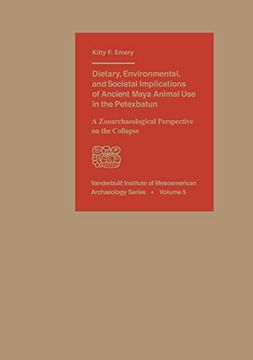Share
Dietary, Environmental, and Societal Implications of Ancient Maya Animal use in the Petexbatun: A Zooarchaeological Perspective on the Collapse. Institute of Mesoamerican Archaeology Series) (in English)
Kitty F. Emery (Author)
·
Vanderbilt Univ Pr
· Hardcover
Dietary, Environmental, and Societal Implications of Ancient Maya Animal use in the Petexbatun: A Zooarchaeological Perspective on the Collapse. Institute of Mesoamerican Archaeology Series) (in English) - Kitty F. Emery
$ 105.21
$ 142.79
You save: $ 37.58
Choose the list to add your product or create one New List
✓ Product added successfully to the Wishlist.
Go to My WishlistsIt will be shipped from our warehouse between
Monday, May 27 and
Tuesday, May 28.
You will receive it anywhere in United States between 1 and 3 business days after shipment.
Synopsis "Dietary, Environmental, and Societal Implications of Ancient Maya Animal use in the Petexbatun: A Zooarchaeological Perspective on the Collapse. Institute of Mesoamerican Archaeology Series) (in English)"
The Classic Maya "collapse" has been attributed to environmental destruction, declining dietary health, and social changes such as increased warfare or changing economies. This study explores these models using ancient animal remains recovered from the Petexbatun archaeological sites.The species found in the Petexbatun faunal collections are compared as proxy evidence for the ancient habitats and landscapes that would have existed around the sites. They reveal that the ancient landscape of the Petexbatun region was not significantly deforested or otherwise destroyed at the end of the Classic period. Bone chemistry of archaeological deer bones confirms that there was no significant expanse of agricultural fields at the expense of forested lands over the occupation of the region. The animal remains are next used to test a related model for the Maya collapse: dietary failure. Comparisons of the remains of food species from residential deposits indicate that the Petexbatun Maya were in no danger of famine or protein deficiency--hey neither overhunted their animal resources nor destroyed their habitats to the extent that dietary species were no longer available.An intriguing deposit of worked animal bone from the capital city of Dos Pilas offers a clue to the puzzle. Here, following the abandonment of the site by the ruling elite, a family group manufactured quantities of utilitarian bone artifacts, probably for trade with other scattered communities in the region. This finding suggests the importance of re-evaluating socioeconomic causality for this transitional period in the Petexbatun and elsewhere in the southern Maya lowlands.VIMA Series #5
- 0% (0)
- 0% (0)
- 0% (0)
- 0% (0)
- 0% (0)
All books in our catalog are Original.
The book is written in English.
The binding of this edition is Hardcover.
✓ Producto agregado correctamente al carro, Ir a Pagar.

